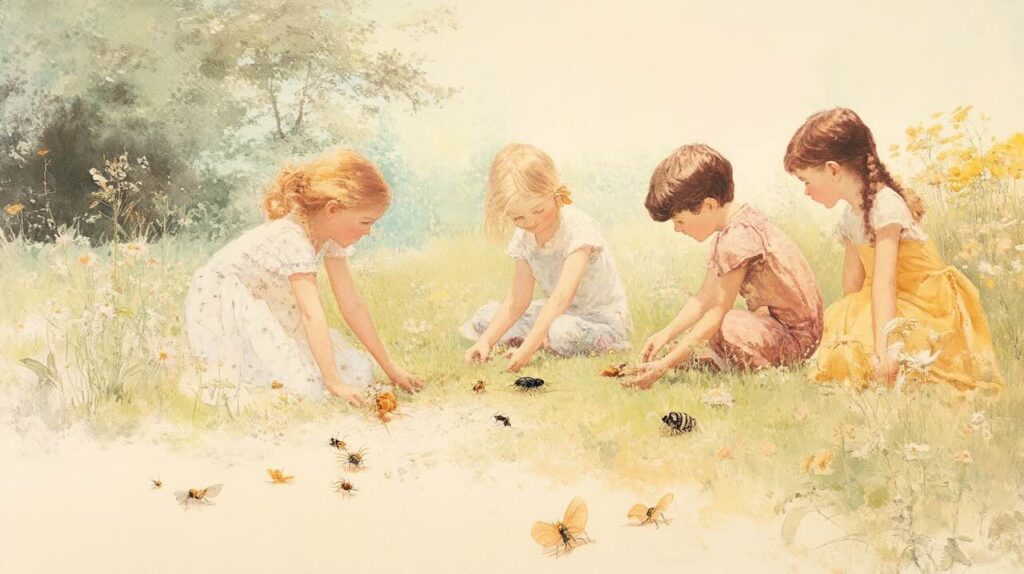For many outside of Japan, the image of children joyfully chasing beetles and cicadas with insect nets may seem quaint or unusual. Yet in Japan, insect catching (mushitori, 虫取り) is far more than a simple summer pastime — it represents a rich blend of education, culture, nature appreciation, and intergenerational tradition.
Let’s explore why catching insects remains a beloved part of childhood in Japan, and how it differs from similar activities elsewhere in the world.
The Cultural Significance of Insect Catching in Japan
A National Summertime Ritual
Every summer, as cicadas hum and forests burst into green, Japanese children head outdoors armed with:
- Lightweight insect nets
- Transparent bug cages
- Specially designed beetle jelly (insect food)
- Guidebooks detailing local species
This tradition is often shared between parents and children, evoking nostalgia for many adults who once did the same during their own youth. For generations, summer insect hunting has symbolized carefree childhood in Japan, deeply tied to seasonal rhythms and family bonding.
Educational Roots: A Legacy of the Meiji Period
Japan’s modern education system, developed during the Meiji era (1868–1912), placed strong emphasis on natural sciences:
- Children were encouraged to study insects firsthand as part of their early science education.
- Observation, collection, and journaling became common school assignments, especially as summer vacation science projects.
- This hands-on learning approach continues to this day, helping children develop both scientific curiosity and environmental awareness.
What Makes Japanese Insect Catching Unique?
Unlike casual bug catching seen elsewhere, Japanese insect catching has evolved into a full cultural phenomenon with its own infrastructure:
Specialized Equipment & Commerce
- Insect nets and cages specifically designed for children.
- Pet shops selling live rhinoceros beetles (kabutomushi, カブトムシ) and stag beetles (kuwagata, クワガタ).
- Beetle food products, including high-protein gels.
- Educational magazines, books, and even video games devoted to insect care and collection.
The Star Insects of Japanese Summers
While butterfly collecting is popular globally, Japanese children often seek:
- Kabutomushi (rhinoceros beetles) – prized for their powerful horns.
- Kuwagata (stag beetles) – admired for their large mandibles.
- Semi (cicadas) – iconic summer soundtrack across Japan.
- Suzumushi (bell crickets) – known for their calming autumn chirps.
These insects hold symbolic status in Japanese culture, appearing frequently in poetry, art, anime, and advertising.
Media Integration
Insects play starring roles across Japanese media:
- Featured in anime and manga like Pokémon, Mushiking, and Shonen Ashibe.
- Depicted in children’s books and seasonal haiku.
- Referenced in traditional wabi-sabi aesthetics that celebrate impermanence and nature’s beauty.
Environmental Awareness
Through insect catching, children develop:
- Respect for nature’s cycles.
- Understanding of seasonal changes and local biodiversity.
- Early lessons in ecological balance and conservation.
Global Comparison: How Japan’s Approach Stands Apart
| Aspect | Western Approach | Japanese Approach |
|---|---|---|
| Audience | Primarily adult hobbyists | Child-centered cultural activity |
| Focus | Scientific study and preservation | Live observation, enjoyment, and temporary care |
| Insects Collected | Butterflies, moths, specialized research specimens | Beetles, cicadas, crickets (popular and accessible species) |
| Infrastructure | Limited | Extensive commercial market (shops, gear, books, events) |
| Cultural Role | Niche hobby or professional research | National summertime tradition and nostalgic symbol |
Modern Challenges and Adaptations
Environmental Concerns
- Urbanization and habitat loss have led to declining insect populations.
- Over-collection in some areas poses conservation challenges.
- There is increasing emphasis on sustainable collecting practices and responsible care.
Modern Solutions
- Urban insect parks and nature reserves help children safely observe insects.
- School programs teach ethical collecting and respect for wildlife.
- Digital apps allow children to track, photograph, and catalog insect encounters without needing physical capture.
- Conservation groups promote insect-friendly gardens to support urban biodiversity.
Why Insect Catching Endures in Japan
Despite smartphones, video games, and urban lifestyles, insect catching persists because it offers:
- Outdoor physical activity during school breaks.
- Intergenerational bonding between parents and children.
- Sensory, hands-on science education.
- A way to slow down and reconnect with nature in an increasingly digital world.
In many ways, it mirrors Japan’s broader cultural emphasis on respecting seasonal change, natural balance, and the simple joys found in everyday life.
Summary
In Japan, insect catching is far more than just bug hunting — it’s a cherished childhood rite, deeply embedded in national identity, education, and environmental philosophy. While similar activities exist worldwide, Japan’s unique combination of cultural integration, educational support, commercial infrastructure, and environmental mindfulness makes its mushitori tradition truly distinctive.
The next time you hear the hum of cicadas in a Japanese summer, remember: behind each child chasing beetles lies centuries of cultural heritage, quietly teaching lessons about life, nature, and the fleeting beauty of the seasons.


